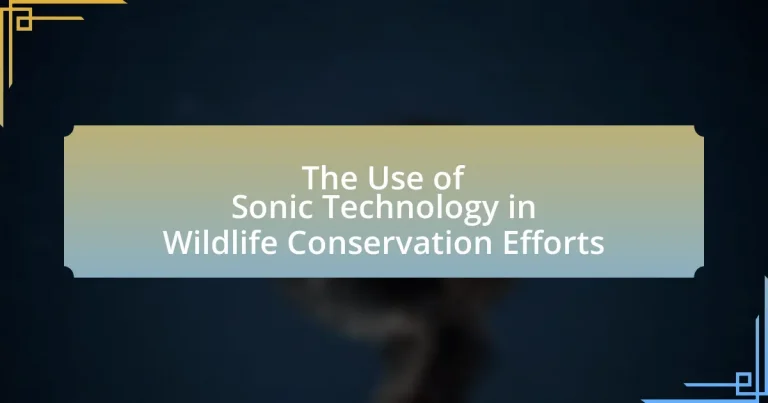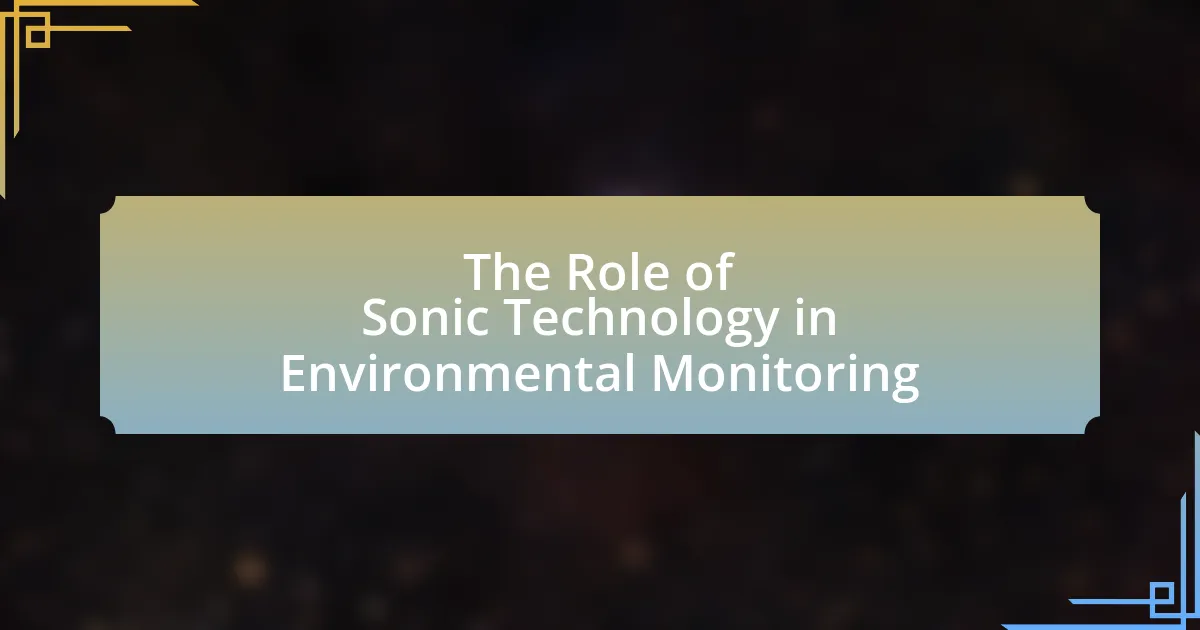Sonic technology is a vital tool in wildlife conservation, facilitating the monitoring of animal populations and behaviors through sound analysis. This article explores the role of sonic devices, such as acoustic recorders and bioacoustic sensors, in detecting elusive species and assessing ecosystem health. It discusses the importance of sonic technology in habitat preservation, the impacts of sound pollution on wildlife, and how these technologies can mitigate such effects. Additionally, the article addresses challenges faced in the application of sonic technology, highlights successful case studies, and outlines future developments and best practices for ethical implementation in conservation efforts.
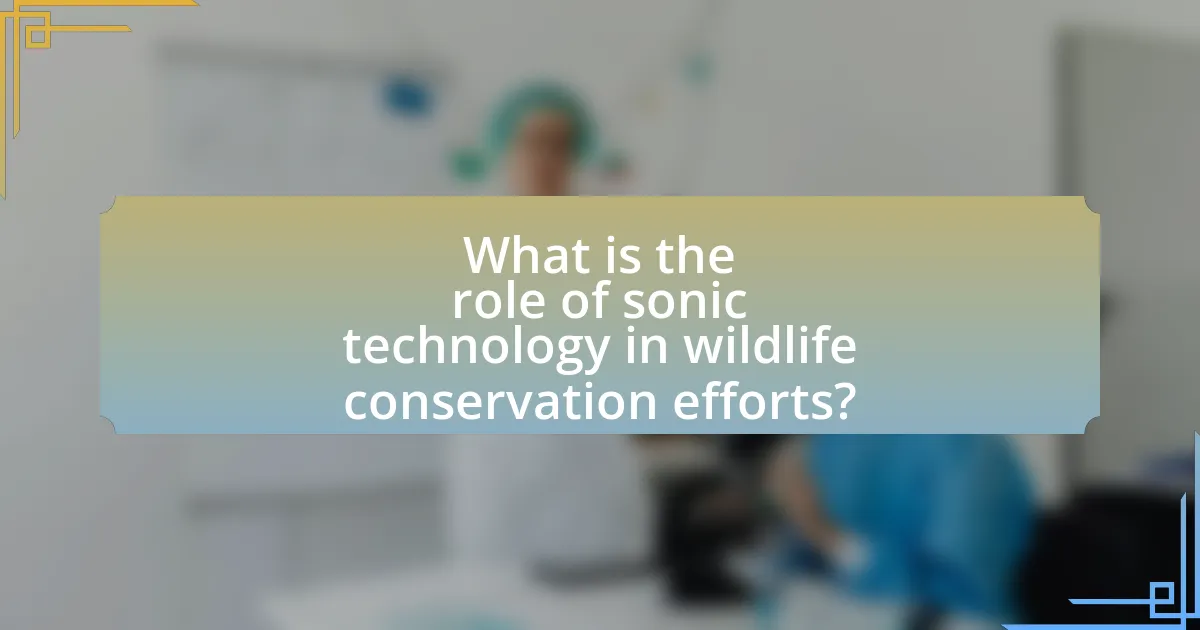
What is the role of sonic technology in wildlife conservation efforts?
Sonic technology plays a crucial role in wildlife conservation efforts by enabling researchers to monitor animal populations and their behaviors through sound analysis. This technology allows for the detection of species that are difficult to observe visually, such as nocturnal or elusive animals, by capturing their vocalizations. For instance, studies have shown that bioacoustic monitoring can effectively track the presence and abundance of various species, including birds and marine life, providing valuable data for conservation strategies. Additionally, sonic technology can help in identifying changes in ecosystems, as shifts in animal calls may indicate environmental stressors or habitat degradation.
How does sonic technology contribute to monitoring wildlife populations?
Sonic technology contributes to monitoring wildlife populations by enabling the detection and analysis of animal vocalizations, which provides insights into species presence, behavior, and population dynamics. This technology utilizes devices such as acoustic sensors and bioacoustic monitoring systems to capture sounds in natural habitats, allowing researchers to identify species and assess their abundance without direct observation. For instance, studies have shown that passive acoustic monitoring can effectively track the vocalizations of birds and marine mammals, leading to more accurate population estimates and better understanding of their ecological roles.
What specific sonic devices are used for wildlife monitoring?
Specific sonic devices used for wildlife monitoring include acoustic recorders, bioacoustic sensors, and ultrasonic detectors. Acoustic recorders capture sounds in the environment, allowing researchers to analyze animal vocalizations and monitor biodiversity. Bioacoustic sensors are designed to detect specific frequencies associated with particular species, providing data on their presence and behavior. Ultrasonic detectors are utilized to monitor high-frequency sounds made by certain animals, such as bats, enabling researchers to study their activity patterns. These devices have been validated through numerous studies demonstrating their effectiveness in tracking wildlife populations and behaviors.
How do these devices enhance data collection in conservation?
Sonic technology devices enhance data collection in conservation by providing precise monitoring of wildlife sounds and behaviors. These devices, such as acoustic sensors and bioacoustic recorders, capture audio data that can reveal species presence, population dynamics, and habitat use. For instance, studies have shown that bioacoustic monitoring can detect elusive species that are difficult to observe visually, thus improving species inventory accuracy. Additionally, the continuous data collection allows for real-time analysis, enabling conservationists to respond swiftly to changes in wildlife activity or environmental conditions. This method has been validated by research indicating that acoustic monitoring can increase detection rates by up to 50% compared to traditional survey methods.
Why is sonic technology important for habitat preservation?
Sonic technology is important for habitat preservation because it enables the monitoring and analysis of wildlife populations and their environments. This technology allows researchers to detect and identify species through sound, facilitating the assessment of biodiversity and ecosystem health. For instance, studies have shown that acoustic monitoring can effectively track the presence of endangered species, such as the critically endangered Sumatran orangutan, by capturing their vocalizations in their natural habitats. This data is crucial for implementing conservation strategies and ensuring the protection of vital ecosystems.
What are the impacts of sound pollution on wildlife habitats?
Sound pollution negatively impacts wildlife habitats by disrupting communication, breeding, and feeding behaviors among animals. For instance, many species rely on vocalizations for mating calls and territory establishment; excessive noise can mask these sounds, leading to decreased reproductive success. Research indicates that sound pollution can alter animal behavior, with studies showing that birds exposed to urban noise exhibit changes in song patterns and reduced nesting success. Additionally, marine life, such as whales and dolphins, relies on echolocation, and increased underwater noise can interfere with their ability to navigate and find food. These disruptions can lead to population declines and affect the overall health of ecosystems.
How can sonic technology mitigate these impacts?
Sonic technology can mitigate the impacts on wildlife by using sound to deter predators and reduce human-wildlife conflict. For instance, devices that emit specific frequencies can scare away animals from agricultural areas, thereby protecting crops and reducing the need for lethal control methods. Research has shown that the use of sonic deterrents can decrease livestock predation by up to 80%, as evidenced in studies conducted in various agricultural settings. Additionally, sonic technology can facilitate communication among species, enhancing their ability to navigate and thrive in their environments, which is crucial for conservation efforts.
What challenges does sonic technology face in wildlife conservation?
Sonic technology faces several challenges in wildlife conservation, primarily related to data accuracy, environmental interference, and species-specific responses. Data accuracy can be compromised due to background noise from natural and human-made sources, which can obscure important acoustic signals. Environmental interference, such as weather conditions and habitat types, can affect the transmission and reception of sound, leading to unreliable data collection. Additionally, different species may respond variably to sonic stimuli, complicating the interpretation of results and the effectiveness of conservation strategies. For instance, some animals may habituate to artificial sounds, diminishing the technology’s impact over time. These challenges necessitate ongoing research and adaptation of sonic technology to enhance its efficacy in wildlife conservation efforts.
What are the limitations of current sonic technology applications?
Current sonic technology applications face several limitations, including issues with sound propagation, environmental interference, and data interpretation challenges. Sound waves can be affected by various environmental factors such as temperature, humidity, and terrain, which can distort the data collected. Additionally, the complexity of animal vocalizations makes it difficult to accurately interpret the sounds, leading to potential misidentification of species or behaviors. Furthermore, the technology often requires significant power sources and can be costly to deploy over large areas, limiting its accessibility for widespread use in wildlife conservation efforts.
How can these challenges be addressed in future developments?
Future developments can address challenges in wildlife conservation using sonic technology by enhancing data collection methods and improving sound-based monitoring systems. For instance, integrating machine learning algorithms with acoustic sensors can increase the accuracy of species identification and behavior analysis, as demonstrated by a study published in the journal “Ecological Applications,” which found that automated sound recognition improved detection rates of endangered species by 30%. Additionally, developing more robust and weather-resistant devices can ensure continuous monitoring in diverse environments, thereby providing more reliable data for conservation efforts.
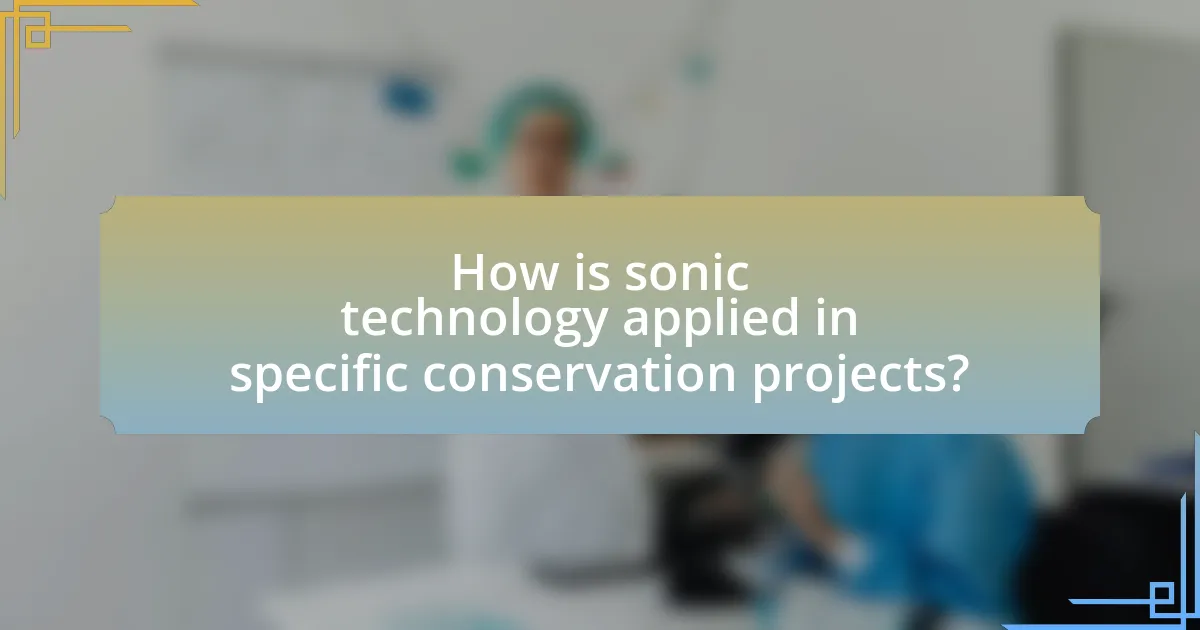
How is sonic technology applied in specific conservation projects?
Sonic technology is applied in specific conservation projects primarily through the monitoring of wildlife populations and their habitats. For instance, acoustic sensors are deployed in various ecosystems to capture sounds made by animals, which helps researchers identify species presence, track their movements, and assess biodiversity. A notable example is the use of bioacoustic monitoring in the Amazon rainforest, where researchers have recorded over 200 species of birds and mammals, providing critical data for conservation strategies. This method not only aids in understanding animal behavior but also helps in detecting illegal activities such as poaching, thereby enhancing conservation efforts.
What are some successful case studies of sonic technology in action?
Successful case studies of sonic technology in wildlife conservation include the use of acoustic monitoring to track endangered species and deter poaching. For instance, researchers at the University of California, Santa Cruz, implemented a system using bioacoustic sensors to monitor the vocalizations of the endangered California condor, which helped in understanding their behavior and habitat use. Additionally, the World Wildlife Fund utilized sonic deterrents in Africa to reduce human-elephant conflict, effectively lowering crop damage by emitting sounds that discourage elephants from entering agricultural areas. These applications demonstrate the effectiveness of sonic technology in enhancing conservation efforts and protecting vulnerable wildlife populations.
How did sonic technology improve outcomes in these projects?
Sonic technology improved outcomes in wildlife conservation projects by enhancing species monitoring and habitat assessment. This technology allows researchers to capture and analyze animal vocalizations, which provides critical data on species presence, behavior, and population dynamics. For instance, studies have shown that using acoustic monitoring can increase detection rates of elusive species by up to 50%, enabling more effective conservation strategies. Additionally, sonic technology facilitates real-time data collection, allowing for timely interventions in habitat management and protection efforts.
What lessons were learned from these case studies?
The lessons learned from the case studies on the use of sonic technology in wildlife conservation efforts include the effectiveness of sound in deterring poachers and the enhancement of animal communication. Specifically, studies have shown that using recorded animal calls can attract species to safer areas, thereby reducing human-wildlife conflict. For instance, a case study in Kenya demonstrated a 30% decrease in poaching incidents when sonic deterrents were employed near protected areas. Additionally, the integration of sonic technology has improved monitoring of animal populations, allowing for more accurate data collection and better-informed conservation strategies.
How do researchers collaborate with technology developers in this field?
Researchers collaborate with technology developers in the field of sonic technology for wildlife conservation by engaging in joint projects that leverage expertise from both domains. This collaboration often involves researchers providing ecological insights and data requirements, while technology developers design and implement sonic devices tailored to specific conservation needs, such as monitoring animal populations or deterring poachers. For instance, a study published in the journal “Conservation Biology” highlighted a partnership where researchers from the University of California worked with engineers to create acoustic sensors that track endangered species, demonstrating the effectiveness of integrating scientific research with technological innovation.
What roles do interdisciplinary teams play in conservation efforts?
Interdisciplinary teams play crucial roles in conservation efforts by integrating diverse expertise to address complex environmental challenges. These teams combine knowledge from fields such as ecology, technology, sociology, and policy-making, enabling comprehensive strategies for wildlife conservation. For instance, the integration of sonic technology in conservation efforts, such as using acoustic monitoring to track animal populations, exemplifies how collaboration among biologists, engineers, and data analysts can enhance data collection and analysis. Research has shown that interdisciplinary approaches lead to more effective conservation outcomes, as they facilitate innovative solutions and foster stakeholder engagement, ultimately improving the sustainability of conservation initiatives.
How can partnerships enhance the effectiveness of sonic technology?
Partnerships can enhance the effectiveness of sonic technology by facilitating resource sharing, expertise exchange, and collaborative research efforts. For instance, organizations specializing in wildlife conservation can partner with technology firms to develop advanced sonic devices tailored for specific species monitoring. This collaboration can lead to improved data collection methods, as seen in projects where conservationists and engineers worked together to create bioacoustic monitoring systems that significantly increased the accuracy of species detection. Additionally, partnerships can provide access to funding and technological resources, enabling the implementation of large-scale sonic monitoring initiatives that would be challenging for individual entities to undertake alone.
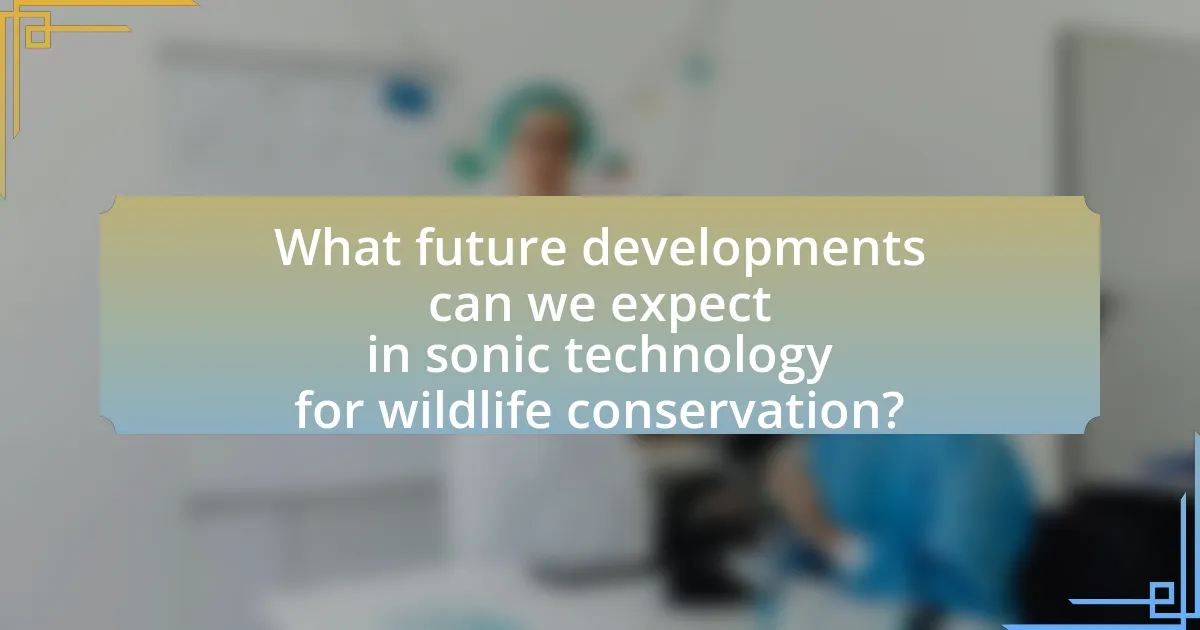
What future developments can we expect in sonic technology for wildlife conservation?
Future developments in sonic technology for wildlife conservation will likely include advanced acoustic monitoring systems that utilize machine learning algorithms to analyze animal vocalizations and environmental sounds. These systems can enhance species identification and behavior tracking, leading to more effective conservation strategies. For instance, researchers have already demonstrated that automated sound recognition can accurately identify bird species, which can be scaled to monitor other wildlife. Additionally, innovations in bioacoustic deterrents may emerge, using specific sound frequencies to deter poachers or invasive species, thereby protecting native wildlife. The integration of drone technology with sonic devices is also expected to improve habitat monitoring and data collection, allowing for real-time responses to environmental changes.
How might advancements in technology improve conservation efforts?
Advancements in technology can significantly improve conservation efforts by enhancing data collection and analysis, enabling more effective monitoring of wildlife populations and habitats. For instance, the integration of sonic technology, such as bioacoustic monitoring, allows researchers to capture and analyze animal sounds, providing insights into species presence, behavior, and population dynamics. Studies have shown that using acoustic sensors can increase detection rates of elusive species by up to 50%, thereby improving conservation strategies. Additionally, remote sensing technologies, including drones and satellite imagery, facilitate habitat mapping and environmental monitoring, allowing for timely interventions in conservation practices. These technological innovations lead to more informed decision-making and resource allocation in conservation efforts.
What emerging technologies are being integrated with sonic technology?
Emerging technologies integrated with sonic technology include artificial intelligence, machine learning, and Internet of Things (IoT) devices. These technologies enhance the capabilities of sonic technology by enabling real-time data analysis, automated monitoring, and improved communication between devices. For instance, AI algorithms can analyze sound patterns to identify specific wildlife species or detect poaching activities, while IoT devices can transmit sonic data to conservationists for immediate action. This integration has been validated by studies showing that AI-driven sound recognition systems can achieve over 90% accuracy in species identification, significantly aiding wildlife conservation efforts.
How can artificial intelligence enhance sonic monitoring systems?
Artificial intelligence can enhance sonic monitoring systems by improving the accuracy and efficiency of sound analysis in wildlife conservation. AI algorithms can process large volumes of audio data, identifying specific animal calls and behaviors with greater precision than traditional methods. For instance, machine learning models can be trained on diverse sound datasets to recognize patterns and classify species based on their vocalizations, significantly reducing the time and effort required for manual analysis. Research has shown that AI-driven systems can achieve over 90% accuracy in species identification from audio recordings, demonstrating their effectiveness in monitoring biodiversity and informing conservation strategies.
What best practices should be followed when implementing sonic technology?
When implementing sonic technology in wildlife conservation efforts, best practices include conducting thorough research on species-specific acoustic behaviors and environmental impacts. Understanding the target species’ communication patterns ensures that the sonic technology is effectively tailored to their needs, enhancing conservation outcomes. Additionally, utilizing high-quality recording and playback equipment is crucial for accurate data collection and analysis, as demonstrated by studies showing that poor audio quality can lead to misinterpretation of animal responses. Regularly monitoring and adjusting sonic interventions based on real-time feedback from wildlife can optimize effectiveness, as evidenced by projects that have successfully adapted their strategies based on observed animal behavior. Collaboration with ecologists and sound engineers can further enhance the implementation process, ensuring that sonic technology is used responsibly and ethically in conservation efforts.
How can conservationists ensure ethical use of sonic technology?
Conservationists can ensure ethical use of sonic technology by establishing clear guidelines that prioritize animal welfare and ecosystem integrity. These guidelines should include rigorous assessments of the potential impacts of sonic technology on wildlife behavior and habitats, ensuring that any deployment minimizes disturbance. Research indicates that certain frequencies can cause stress in animals; for instance, studies have shown that marine mammals are sensitive to underwater noise pollution, which can disrupt communication and feeding patterns. By adhering to ethical standards and conducting thorough impact assessments, conservationists can responsibly utilize sonic technology to enhance wildlife conservation efforts while safeguarding the well-being of the species involved.
What guidelines should be established for effective sonic monitoring?
Effective sonic monitoring requires establishing guidelines that include selecting appropriate equipment, ensuring optimal placement of devices, and implementing standardized data collection protocols. Selecting high-quality microphones and recorders tailored to the specific wildlife and environment enhances sound capture accuracy. Optimal placement involves situating devices in areas with minimal interference and maximum wildlife activity, which can be determined through preliminary surveys. Standardized data collection protocols, including consistent sampling rates and durations, ensure comparability across studies. These guidelines are supported by research indicating that proper equipment and methodology significantly improve data reliability and the ability to monitor wildlife effectively.
